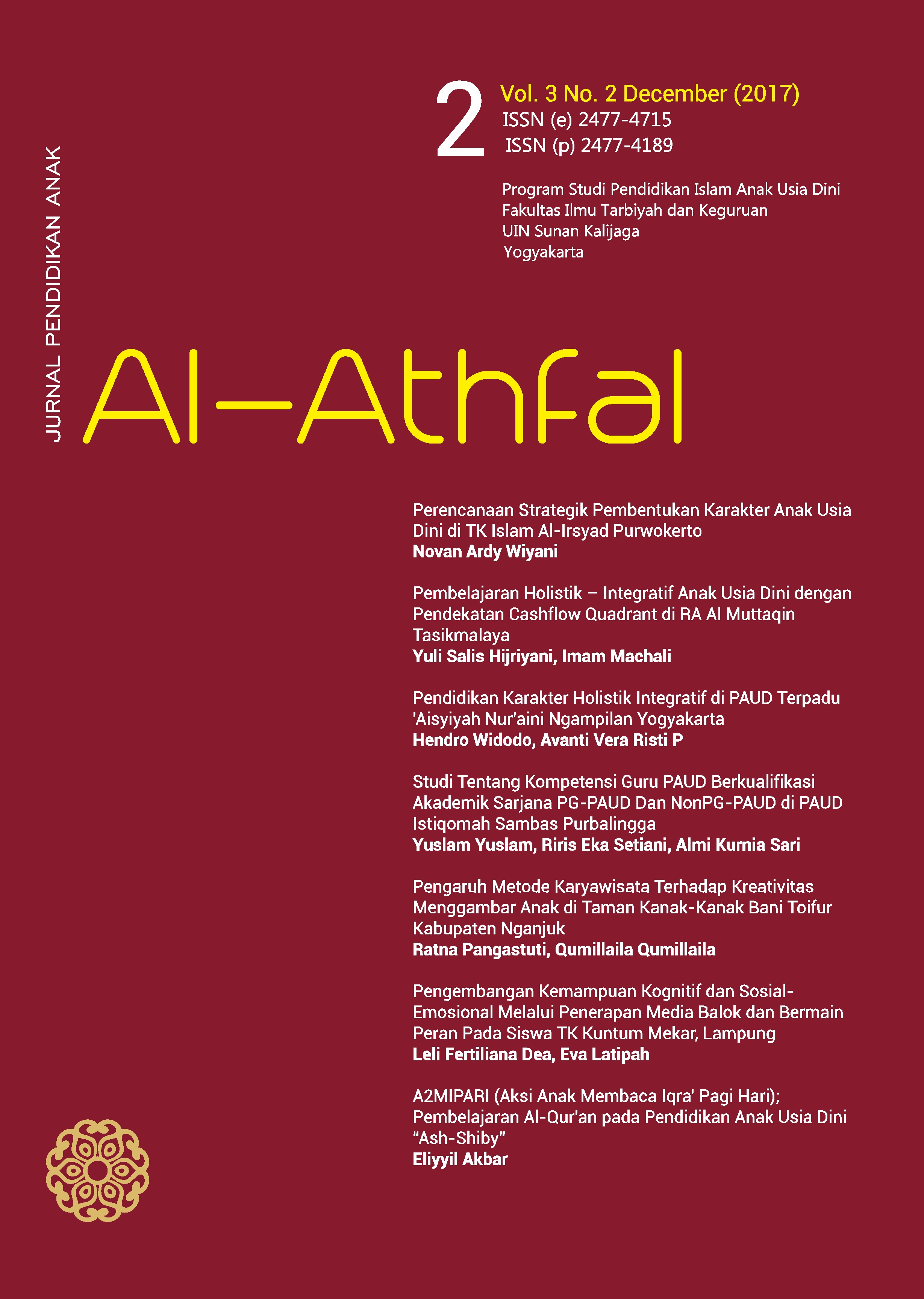971
Views
3707
Downloads
 Open Access
Open Access
Pengembangan Kemampuan Kognitif dan Sosial-Emosional Melalui Penerapan Media Balok dan Bermain Peran Pada Siswa TK Kuntum Mekar, Lampung
Main Article Content
Abstract
This study aims to (1) to determine the use of block media in the cognitive and social development of children in Kuntum Mekar 2 Bandar Lampung, (2) to know the application of bemain role method in developing cognitive and social emotional of children in Kuntum Mekar Kindergarten 2 Bandar Lampung, (3) to know the successful application of block media and role playing method in early childhood cognitive and social development. This research uses qualitative research method, the data obtained through observation to know the initial data of application of block media and the application of role play, interview to get data in condition of cognitive development and social emotional of early child, then the data is analyzed by data reduction, data presentation and concluded. From the analysis of the research, it can be concluded that: First, the application of beam media in Kuntum Mekar TK 2 Bandar Lampung succeeded. Use the following steps: (a) The teacher prepares the tools. (b) The teacher accepts the children present. (c) Master explains how to play blocks. (d) The child builds with the beam and the teacher is just watching. Second, the application of role playing in Kuntum Mekar 2 Bandar Lampung was successful. Apply using the following steps: (a) Teachers collect children for direction and rules in the game, (b) Teacher discusses the tools to be used, (c) Teacher gives assignments to the child. Third, the successful application of beam media and role playing methods in early childhood cognitive and social development is evidenced by children developing as expected, as children are able to recognize objects by function, the child is able to classify objects by shape, color and size, the child is able to recognize the ABC pattern , children are able to recognize the concept of numbers, children are able to say a lot of objects 1-10 and children are able to cooperate with friends, children are able to know etiquette and courtesy in accordance with local social cultural values, children are able to understand the rules and discipline and children are able to show empathy attitude.
Keywords:
Downloads
Article Details
How to Cite
Copyright
Authors who publish with this journal agree to the following terms:
- Authors retain copyright and grant the journal the right of first publication with the work simultaneously licensed under a Creative Commons Attribution License that allows others to share the work with an acknowledgment of the work's authorship and initial publication in this journal.
- Authors can enter into separate, additional contractual arrangements for the non-exclusive distribution of the journal's published version of the work (e.g., post it to an institutional repository or publish it in a book), with an acknowledgment of its initial publication in this journal.
- Authors are permitted and encouraged to post their work online (e.g., in institutional repositories or on their website) before and during the submission process. It can lead to productive exchanges and earlier and greater citation of published work.
References
Depdiknas,Perkembangan Belajar Peserta Didik 3, Jakarta: Bumi Aksara, 2005.
Gunarsa, Singgih D., Psikologi Untuk Keluarga, Jakarta: BPK, Gunung Mulya, 1984.
Mansur, Pendidikan Anak Usia Dini dalam Islam, Jakarta: Pustaka Belajar, 2009.
Mashar, Riana. Emosi Anak Usia Dini dan Strategi Pengembangannya. Jakarta: Kencana Prenada Media Group, 2011.
Mayke Sugianto, T. 1995 Modul APE untuk LPMP Banten. pdf, diakses september 2012.
Sugiyono. Metode Penelitian Pendidikan Pendekatan Kualitatif, Kuantitatif, dan R&B. Bandung: Alfabeta, 2010.
Suryadi, Psikologi Belajar PAUD, Jakarta: Pedagogia, 2010.
Sutopo, H.B. Metodologi Penelitian Kualitatif. Surakarta: Sebelas Maret University Press, 2002.




